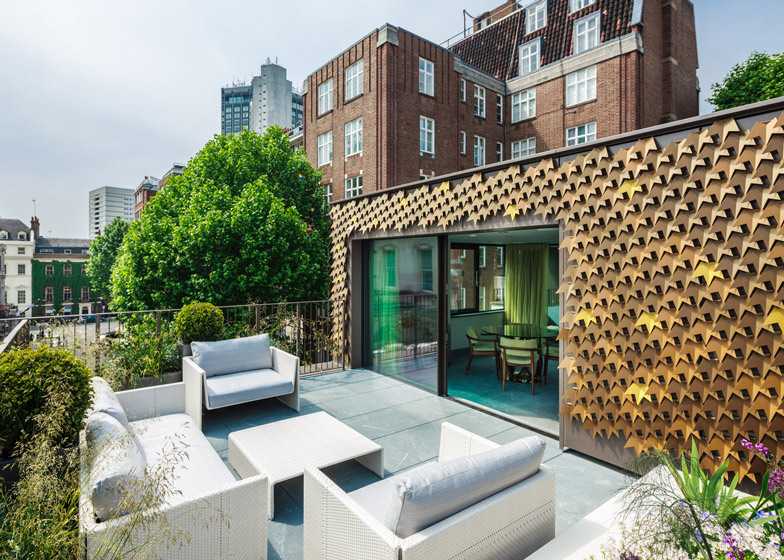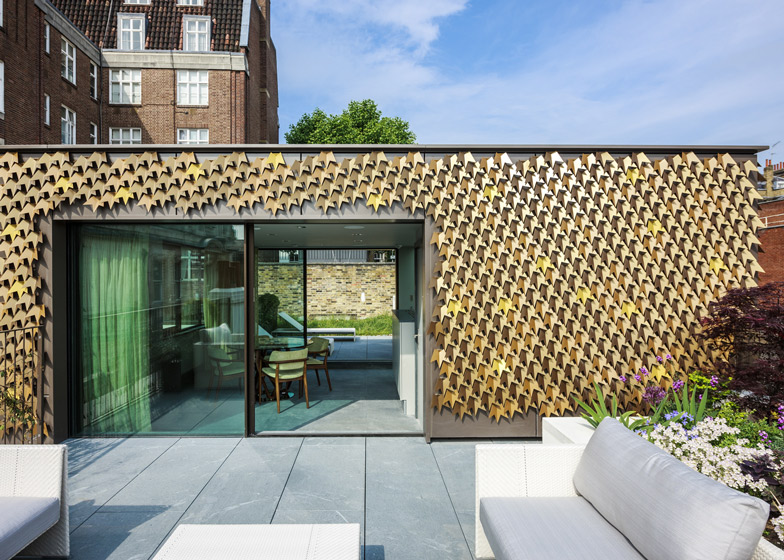A pattern of bronze leaves covers the facade of this house in Mayfair, London, by British architecture firm Squire and Partners (+ slideshow).
Squire and Partners sandwiched the five-storey house between existing buildings, retaining an eighteenth-century facade in front.
The leaf cladding, made from 4080 folded aluminium pieces, was inspired by a nearby building covered with a Virginia Creeper plant.
The building's facades have been designed to fit in with the different areas they face.
"The east and west portions of the building are finished with a stucco render to match the existing Waverton Street facade, with full-height bronze-framed windows of traditional Georgian proportions," said the architects.
"A discreet Cotswold Buff brick facade with oak-framed windows then faces the more utilitarian Red Lion Yard," they added.
The interior features five bedrooms, a swimming pool, gymnasium, cinema, a rooftop pavilion and two separate roof terraces.
A living wall of native plants grows down one side of a lightwell that features in the centre of the house.
Photography is by Gareth Gardner.
Other creative facades in London include a cast iron facade on the Paul Smith store in London, a faceted glass surface on a building in Oxford Street and an office building with four glazed slashes in the aluminium surface.
See more residential architecture stories »
Here's a project description from the architects:
Mayfair House
Squire and Partners approached their commission to design a private house as a crafted building, sensitive to its Mayfair Conservation Area context but with a unique contemporary presence. Sited at a junction of streets and views, and being physically linked to a listed Georgian wall at the termination of Chesterfield Mews facing Curzon Street, the building responds to a variety of contexts and viewpoints.
The project involved the retention of an existing 18th century façade facing Waverton Street, and the design of a new building comprising three linked volumes to create a unique home in central Mayfair. The accommodation provides five bedrooms, a swimming pool, gymnasium, cinema, rooftop pavilion and two separate roof terraces.
Construction involved sandwiching the retained façade between two steel frames which was then suspended while piling and construction of the lower ground floor took place. This floor then became a platform from which excavation of the two basement floors and construction of the concrete frame above could happen simultaneously, speeding up the weather tightness of the site and fast-tracking the programme.
The east and west portions of the building are finished with a stucco render to match the existing retained Waverton Street façade, with full height bronze framed windows of traditional Georgian proportions. A discreet Cotswold Buff brick façade with oak framed windows faces the more utilitarian Red Lion Yard.
The middle part of the building is set back from the restored listed wall on Chesterfield Gardens to create a light well drawing daylight into the central spaces, and features a playful bespoke leaf façade.
The façade of this element takes inspiration from a facing building on Curzon Street, mirroring an established Virginia Creeper with a contemporary interpretation of leaves expressed as a metallic shingle.
The PPC coated folded aluminium leaves – 4,080 in total - subtly vary in tones of bronze to mimic organic growth patterns, and clad a three storey elevation facing Curzon Street including a rooftop pavilion.
At the centre of the c-shaped building internally, a grand double height space gives views into the light well which features a living wall planted with a variety of native plants.
Social spaces are located off the main double height volume, with the gymnasium, cinema and swimming pool situated in the two basement floors. Bedrooms are organised on the upper two levels, above which sits the stunning leaf- clad rooftop pavilion.
Westminster planning committee described the proposal as ‘striking’ and ‘raising the bar for design within the borough’.
Project Team
Client: Central Investment Properties Architect: Squire and Partners
M&E: Wallace Whittle UK Ltd
Structure: Heyne Tillett Steel
Quantity Surveyor: Rider Hunt
Planning Consultant: The London Planning Practice
Contractor: GPF Lewis Ltd
Interior Designer: Bill Bennette Landscaping: Haynes Design



